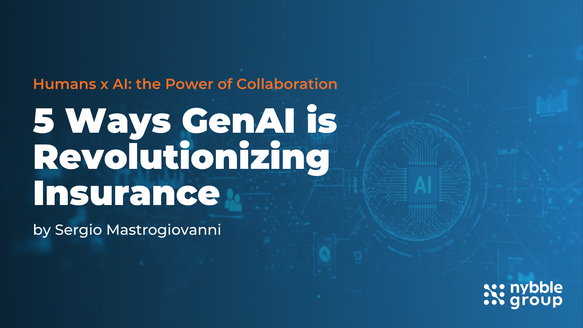Welcome to Life of AI: Powering the Software Development Lifecycle! We created this series to share a little bit more about how Innovation transforms everything we do, taking a closer look at how AI is reshaping the ins and outs of building software.
We’re kicking things off with a look at the SDLC—a solid framework for building reliable, scalable software. But don’t expect the usual breakdown! We’ll be exploring the SDLC through a fresh, AI-powered lens. As we dive into how AI is reshaping software development, you’ll see how smart algorithms and machine learning are bringing new levels of efficiency, agility, and innovation to each step.
As we go, we’ll show off our unique spin on an AI-powered SDLC. By blending human creativity with the latest tech, we go beyond traditional software to build solutions that make a real impact. This article is just a starting point, though—the journey’s just getting started! In the next few articles, we’ll dive deeper into each SDLC stage, showing how AI tools are woven into our approach to delivering Solutions That Matter.
So, let’s embark on this journey together—one that will redefine how you think about software development and the role of AI in shaping a smarter, more responsive SDLC. Let’s begin by exploring!
What is SDLC? Understanding the Software Development Lifecycle
The Software Development Lifecycle (SDLC) is a structured framework that guides the process of software development, from the early stages of conceptualization to deployment and maintenance. It’s a cycle that enables developers to create software with a clear roadmap, ensuring quality, efficiency, and alignment with business goals.
At its core, the SDLC consists of several key stages:
- Discovery: where the project vision starts coming together—gathering requirements, setting goals, and figuring out what end-users and stakeholders really need.
- Design: during this phase, teams put together a blueprint for the software—mapping out the technical details and designing how the user experience will look and feel.
- Develop: where actual coding and creation of the software happens, along with continuous testing to maintain quality.
- Deploy: in this phase, the software is delivered to the end-users, whether it’s done in stages or all at once.
- Support: regular maintenance, updates, and enhancements that keep the software running smoothly and ensure it meets evolving user needs.
A Brief History of the Software Development Lifecycle
The Software Development Lifecycle (SDLC) goes way back to the early days of computer science. It all started in the 1950s and 60s, when organizations realized they needed a better way to manage complex software projects. Back then, projects often ran into problems with budgets, delays, and quality issues. To get things under control, engineers borrowed waterfall-style models from manufacturing and engineering to help bring some order to the process.
The Waterfall Model, one of the first SDLC frameworks, was introduced by Dr. Winston W. Royce in 1970. It broke down the software development process into clear steps: Requirements, Design, Implementation, Verification, and Maintenance. While it was a pretty rigid approach, it gave teams a solid roadmap to follow, which helped cut down on errors and made big projects more predictable.
By the 80s and 90s, as tech and business needs picked up speed, the limits of the waterfall model started to show. Teams needed more flexibility and room for ongoing improvements, which led to the rise of Agile and Iterative Development models. These new methods made it easier to adapt to changes, test constantly, and get regular client feedback—perfect for the fast pace of the digital age.
The digital transformation of the SDLC took off in the 2000s and hasn’t slowed down since. With the boom in internet tech, cloud computing, and mobile apps, software development had to get faster and more flexible. This is when DevOps and CI/CD pipelines came onto the scene, blending development with operations to make deployments smoother and boost teamwork.
Now, with AI and automation tools, the SDLC has hit a whole new level. AI helps teams manage huge data loads, predict user behavior, automate testing, and even generate code. It’s turned the SDLC from a step-by-step process into a smart, flexible cycle that keeps up with the fast-paced digital world. Ready to see how?
How AI is Transforming the SDLC
AI is making the SDLC way more efficient and precise. Let’s take a look at how it’s shaking things up at each stage of the process.
1. Discovery with AI
AI tools can quickly analyze user data, market trends, and business processes like never before. By using AI in the Discovery phase, developers get a clearer picture of the project’s goals and limitations, helping them better align with business needs.
2. Design with Predictive Models and Prototyping
In the Design phase, AI helps by predicting how users will behave and what they’ll like. With machine learning models, AI can suggest interface designs that are most likely to click with users, making prototyping faster and cutting down on the guesswork.
3. Development with AI Pair Programming
In the Development phase, AI works like a “pair programmer,” helping with code generation, bug detection, and improving code quality. Advanced tools like AI code assistants can cut down coding time, especially for repetitive tasks, so developers can focus on solving bigger problems.
4. Deployment with Continuous Monitoring
AI monitoring tools help make sure software deployments go smoothly and flag any issues right away. With real-time analytics and anomaly detection, AI boosts the reliability and security of the deployment, leading to better user satisfaction.
5. Support with Predictive Maintenance
In the Support phase, AI can predict when maintenance will be needed before problems pop up. This proactive approach helps keep the software running longer, avoids downtime, and lets teams use their resources more efficiently.
Why Choose an AI-Enhanced SDLC?
Using an AI-driven SDLC offers businesses several competitive advantages:
- Efficiency Gains: Automation reduces time spent on repetitive tasks, allowing teams to focus on innovation.
- Enhanced Accuracy: AI algorithms reduce human error, especially in code development and testing.
- Cost-Effectiveness: Faster turnaround times mean lower project costs and quicker time-to-market.
- Scalability: An AI-powered approach makes it easier to scale projects and adapt to new business needs or technologies.
With our expertise in AI-enhanced SDLC, we deliver solutions that matter—agile, efficient, and custom-built to transform through innovation and drive sustainable growth.
Glimpse Ahead in "Life of AI"
AI is completely changing the game when it comes to the Software Development Lifecycle. By automating and streamlining each stage, AI helps development teams work faster, smarter, and stay better aligned with business goals. Our AI-enhanced SDLC brings this potential to life, combining human creativity with cutting-edge tech to deliver Solutions that truly transform.
This article is just the start. In the rest of this series, we’ll break down each stage of the SDLC and show how AI boosts each one. Join us as we dive into the world of AI and software development in our Life of AI series. Next up: The Discovery Phase—where we’ll explore how AI lays the foundation for project success. Stay tuned!




